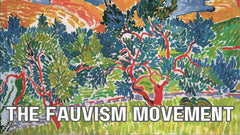Raoul Dufy: Fauvist Luminary
Table of Contents:[hide]
Raoul Dufy, a luminary of the Fauvist movement, remains an enduring figure in the annals of art history. His vibrant and decorative style not only graced canvases but also found its way into textiles, public buildings, and various other mediums. Let's delve into the life and works of this influential French painter, exploring the depths of his artistic journey and the legacy he left behind.
Early Beginnings and Influences
Born on June 3, 1877, in Le Havre, Normandy, Dufy's artistic journey began modestly. At age 14, he embarked on a path that would ultimately lead him to the pinnacle of artistic acclaim. His formal training commenced at Le Havre's École des Beaux-Arts under the tutelage of Charles Lhuillier, where he honed his craft alongside notable contemporaries like Raimond Lecourt and Othon Friesz.
Dufy's early works predominantly captured the essence of Norman landscapes in watercolors, reflecting the serene beauty of his surroundings. However, it was his encounter with the works of impressionist masters like Claude Monet and Camille Pissarro that ignited the flames of his artistic fervor. The vibrant colors and bold strokes of the Fauvist movement, particularly Henri Matisse's "Luxe, Calme et Volupté," captivated Dufy, redirecting his artistic trajectory towards a bolder, more expressive style.
Evolution of Style: From Fauvism to Distinctive Stenographic Technique
Dufy's artistic evolution is a testament to his relentless pursuit of innovation. While initially enamored with the exuberant palette of Fauvism, Dufy's encounter with the works of Paul Cézanne prompted a subtle shift in his technique. By 1920, he had developed his distinctive stenographic approach characterized by skeletal structures and rapid, thin color washes.
This unique style found expression in his portrayal of contemporary scenes, from yachting events to elegant social gatherings along the French Riviera. One of his most celebrated works, "La Fée Electricité," created for the 1937 Exposition Internationale in Paris, stands as a towering testament to his mastery of form and color.
Beyond the Canvas: Dufy's Multifaceted Talents
Dufy's artistic prowess transcended traditional boundaries, extending into the realms of illustration, design, and commercial art. He lent his talents to diverse projects, from painting murals for public buildings to designing textiles for renowned fashion houses like Paul Poiret. His collaboration with Bianchini-Ferier resulted in exquisite textile patterns that adorned garments worn by the fashion elite.
Legacy and Influence
Despite facing physical challenges in his later years due to rheumatoid arthritis, Dufy's creative spirit remained undimmed. His legacy endures through his timeless artworks, which continue to inspire and captivate audiences worldwide. Dufy's influence reverberates through the realms of art and design, serving as a source of inspiration for generations of artists.
Conclusion
Raoul Dufy's artistic journey is a testament to the transformative power of creativity. From humble beginnings in Le Havre to international acclaim, Dufy's legacy continues to shine brightly in the annals of art history. His vibrant and expressive style, coupled with his multidisciplinary approach to art, ensures his enduring relevance in the ever-evolving landscape of artistic expression.
Raoul Dufy Prints and Canvas Panels
Prints and ready to hang canvas panels of Raoul Dufy's paintings are available in a range of sizes with fast worldwide delivery.
Raoul Dufy FAQ's
-
Who was Raoul Dufy?
- Raoul Dufy (1877-1953) was a renowned French painter associated with the Fauvist movement known for his vibrant and decorative style.
-
What is Fauvism, and how was Dufy involved in it?
- Fauvism was an early 20th-century art movement characterized by bold colors and simplified forms. Dufy was deeply involved in Fauvism, drawing inspiration from fellow artists like Henri Matisse and contributing to its vibrant aesthetic.
-
What are some notable characteristics of Dufy's artistic style?
- Dufy's style was characterized by vibrant colors, bold contours, and a lively, expressive quality. He often depicted scenes of outdoor social gatherings, yachting events, and views of the French Riviera.
-
How did Dufy's style evolve over time?
- Initially influenced by Fauvism, Dufy's style underwent changes after encountering the works of Paul Cézanne. He developed a distinctive stenographic technique, characterized by skeletal structures and rapid, thin color washes.
-
What mediums did Dufy work in, besides painting?
- In addition to painting, Dufy was skilled in drawing, printmaking, book illustration, scenic design, furniture design, and planning public spaces. He also ventured into commercial art, designing textiles, ceramics, and stationery.
-
What are some notable works by Raoul Dufy?
- Some of Dufy's notable works include "La Fée Electricité," a large-scale painting celebrating electricity, and various murals, tapestries, and ceramic designs. He also illustrated books by prominent writers such as Guillaume Apollinaire and André Gide.
-
How did Dufy's physical health impact his later artistic output?
- In his later years, Dufy faced challenges due to rheumatoid arthritis, which impaired his ability to paint. Despite this, he continued to create art, adapting his techniques to accommodate his physical limitations.
-
What was Dufy's influence on the world of art and design?
- Dufy's influence extended beyond the realm of fine art, shaping textile design, fashion, and commercial art. His vibrant aesthetic and innovative approach continue to inspire artists and designers to this day.
-
Where can one view Raoul Dufy's artworks?
- Dufy's works are held in various public collections worldwide, including museums such as the Art Institute of Chicago, the Musée d'Art Moderne de Paris, and the National Gallery of Art in Washington, D.C.
-
What is Raoul Dufy's legacy in the context of art history?
- Raoul Dufy's legacy lies in his pioneering spirit, creative innovation, and enduring contribution to the world of art. His vibrant artworks continue to captivate audiences and serve as a testament to his artistic genius.






















